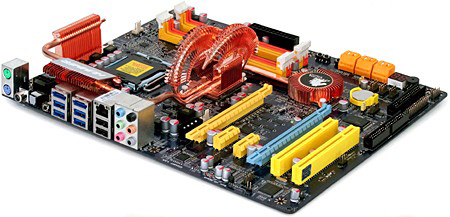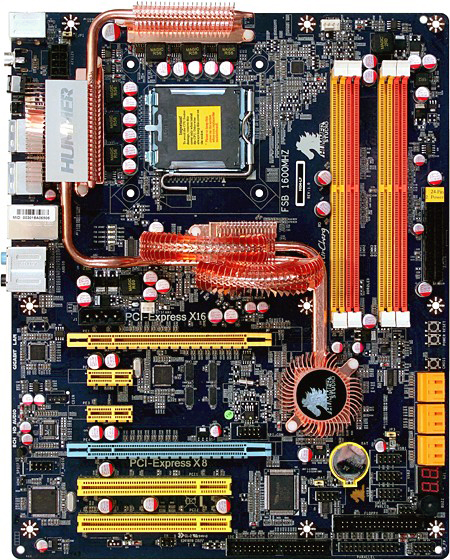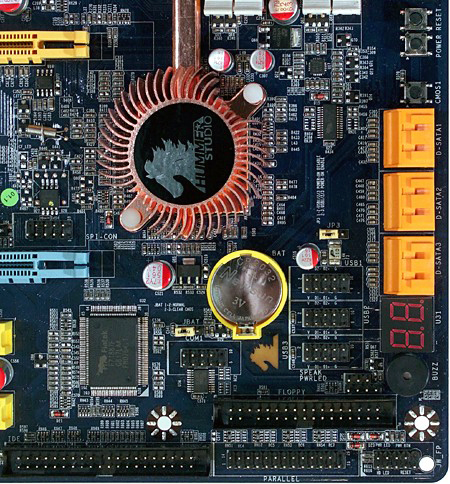11-Way P45 Motherboard Shootout
Jetway HI04
We like short names and tall features, and Jetway is usually a primary candidate for value seekers. Anyone unfamiliar with the company’s long history wouldn’t know that its most historically-significant products were probably the ones re-branded by a certain large graphics firm, but any technology company able to hold its market for 22-years must be doing something right. While we haven’t seen the HI04 hit Web vendors yet, its own-brand pricing history has been consistent enough for us to peg its new HI04 at around $140 from one of the big-three discount Web vendors.
The first thing casual observers will notice about the HI04 is its large, twin semi-circular northbridge sinks, which are reminiscent of competitor MSI’s former circular design. The more experienced builders will also notice that this “budget brand” model is packed with features such as onboard digital audio connectors, eSATA ports, electronic dual-graphics mode switching, and a POST code display.
That is to say, Jetway tries to provide the best of every manufacturer in its price range. For example, the electronic PCI Express selectors, which automatically change the slots from a single-graphics x16 mode to dual x8 modes when a second card is installed, is only found on one of three competing sub-$150 models in today’s comparison. The use of reliability-enhancing solid capacitors in all locations is found on two completely different models. And while only one of the sub-$150 competitors offers twin eSATA ports, the rear-panel digital audio ports are only offered by a completely different competitor.
Like the best of its competitors, Jetway puts its eight-pin and 24-pin ATX/EPS power connectors almost ideally in the rearward-top and upper-front edges, and spaces its two PCI Express x16 slots three rows apart for better card cooling. But Jetway goes a little farther than any of its direct competitors in VRM design and cooling, with a six-phase voltage regulator tied to an elaborate heat-pipe assembly.
That’s not to say the HI04 layout is perfect, however, as it also has some of its competitor’s worst traits. For example, the floppy and Ultra ATA headers are still at the bottom edge, even if they aren’t tucked away under the PCI slot. And the front-panel audio connector is just far enough from the bottom edge that it can’t properly be reached by cables routed under or over the board. Furthermore, while most of the slots the HI04 has are well placed, the top slot position is occupied by an auxiliary power connector rather than an x1 slot. Since most users won’t or can’t use the slot directly beneath the primary graphics card, it would have been nice to see it placed where the auxiliary power connector resides.
The Jetway HI04 is the only sub-$150 motherboard in today’s comparison that doesn’t have socketed BIOS. That means hot flashing isn’t an option for BIOS modders, and a bad flash would require sending the entire motherboard to the factory for warranty replacement. Though a bad flash isn’t a common problem, we’ve all been stuck with it a few times.
It’s nice to see that Jetway provides three USB 2.0 headers internally to support up to six front-panel USB ports or devices, but the six Serial ATA connectors next to them face forward, which can conflict with the lower hard drive cage of many ATX tower cases. Had the headers faced upwards, they would have been blocked by graphics cards. The only perfect solution would be to move them, but that’s easier said than done.
Get Tom's Hardware's best news and in-depth reviews, straight to your inbox.
Reset, power, and CLR_CMOS buttons above the Serial ATA ports are handy for bench testing, while the two-digit POST code display helps overclockers determine what limitations they might have exceeded. Jetway also provides parallel and serial port headers nearby for anyone who needs them and can still find a standard breakout cable set.
Current page: Jetway HI04
Prev Page EP45-DQ6 Software And Accessories Next Page HI04 Onboard Devices-
nickchalk Where are the lower price P45 M/B ?Reply
Asus P5Q pro is out for €110 and P5Q deluxe for €165 the price difference is about 70$ in Greece. -
Proximon I suppose I can get some good from having read this. Did you get paid by the word? Maybe next time you could just put together a complete features chart so that we can have some convenient comparison? You know, so someone could go to a chart and see at a glance which boards had eSATA or firewire, or 8 USB.Reply
-
JPForums I'd rather have the overabundance of information than a lack of information. Presentation could use a little refining (I.E. comparison charts and the likes), but having the relevant information available at least is a good thing.Reply -
the introduction and specifics are nice, the comparision isn't. so, why don't you test with an 8500 or qx9650? 6850 are outdated... and a mobo handling a c2d doesn't mean it can handle a quad too, see P5K for example (it stinks when it comes to a q6600).Reply
-
Crashman procithe introduction and specifics are nice, the comparision isn't. so, why don't you test with an 8500 or qx9650? 6850 are outdated... and a mobo handling a c2d doesn't mean it can handle a quad too, see P5K for example (it stinks when it comes to a q6600).Reply
Tom's Hardware wants the performance of current articles to reflect that of recent articles, so a "standard test platform" was chosen a while ago. It will get updated, but probably not before the new socket becomes widely available. -
zenmaster I would have liked to see something such as a P35 and an X48 as controls to help analyze the P45 Performance.Reply
In otherwords, What is the P45 Gaining me over the older P35.
What would I gain by going to the X48. (Or Lose) -
Crashman zenmasterI would have liked to see something such as a P35 and an X48 as controls to help analyze the P45 Performance.In otherwords, What is the P45 Gaining me over the older P35.What would I gain by going to the X48. (Or Lose)http://www.tomshardware.com/reviews/intel-p45-chipset,1961.htmlReply -
johnbilicki The first 17 pages were filled with nothing but junk from ASUS. Do us a favor: don't even bother featuring or *MENTIONING* anything for any reason from a company that refuses to RMA 200-400 dollar brand new motherboards with anything other then used and usually broken junk. It destroyed my enthusiasm for the article.Reply -
dobby nickchalkWhere are the lower price P45 M/B ?Asus P5Q pro is out for €110 and P5Q deluxe for €165 the price difference is about 70$ in Greece.Reply
the p5q PRo is a p43 board, i should know i have one



